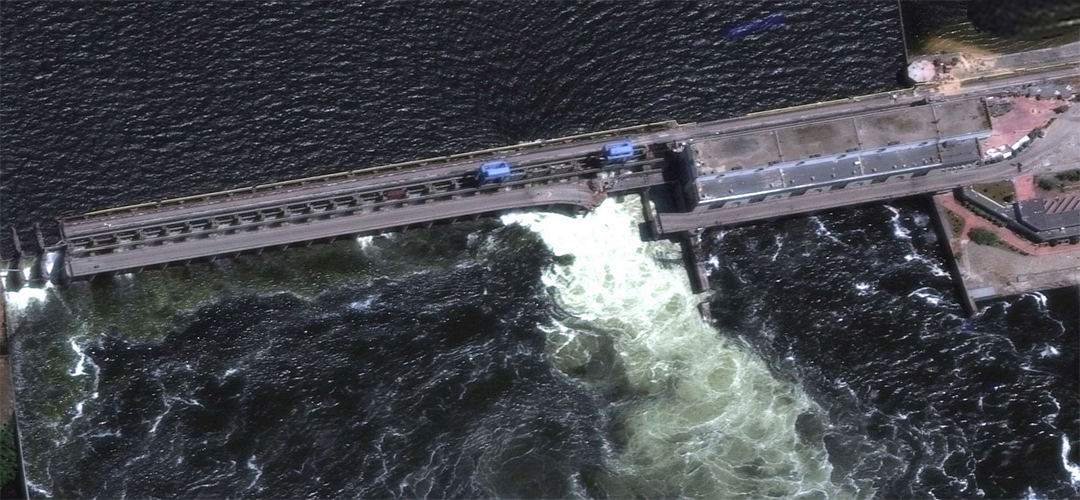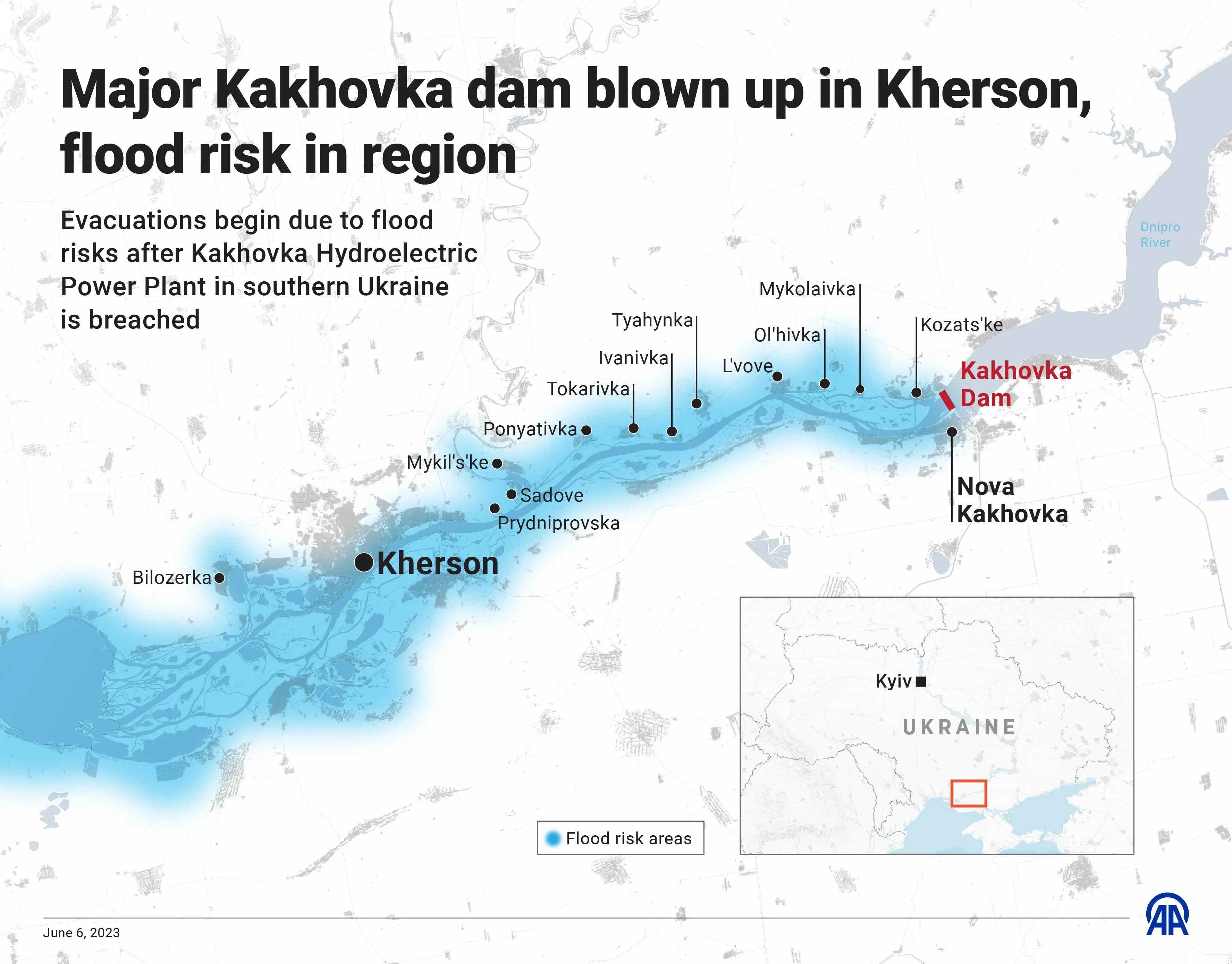Dam Destruction: Operational Imperative or Eco Warfare?
June 17, 2023 | Expert Insights

On June 8, 2023, a massive breach occurred in the Nova Kakhovka dam in Ukraine, unleashing a devastating flood. The dam is located in the Kherson region, currently under Russian occupation. The breach caused widespread flooding in the region, displacing thousands of people and destroying homes, businesses, and infrastructure.
The cause of the breach is still under investigation. Ukraine's military and NATO have accused Russia of blowing up the dam, while Russia has blamed Ukraine.
Background
The incident was reminiscent of the now famous ‘Dam Buster’ raid by the RAF in May 1943, in which three dams in the heavily industrialised Ruhr valley were attacked. Two dams were breached, while the third sustained only minor damage. The industrial base of Ruhr Valley was deprived of electricity and water for weeks, and nearly 2000 civilians, including Russian slave labourers, were drowned. The actual impact on Nazi Germany's war-making capacity is debated to date.
The breaching of the Nova Kakhovka Dam has similarly mostly impacted civilians. Thousands of people have been displaced from their homes, and many have lost everything they own. The flooding has also damaged or destroyed critical infrastructure, including roads, bridges, and power lines. This has made it difficult for aid agencies to reach the affected areas and provide assistance. The Nova Kakhovka dam incident is a reminder of the human cost of the war. The flooding has caused widespread suffering and displacement, and it will take years for the region to recover.
In addition to the human cost, the Nova Kakhovka dam incident has had a significant environmental impact. The flooding has contaminated drinking water supplies, damaged agricultural land, and disrupted wildlife habitats. The long-term environmental impact of the incident is still being assessed.
The incident has also raised concerns about the safety of other dams in Ukraine. There are over 1,000 dams in Ukraine, many of which are located in areas currently under Russian occupation.

Analysis
While objectively assessing the outcome of the dam destruction, it can be seen that both sides stand to gain or lose from this incident. However, apart from the ecological and economic prism, one must also look at this incident in the context of the much-anticipated Ukrainian counteroffensive that has been a year in coming with the full backing of the West.
Russians claim that the extensive flooding has forced them to evacuate troops from frontlines that were held in anticipation of the imminent Ukrainian counteroffensive, leaving wide swathes of the Dnipro Riverbank upheld, which no military likes as the river obstacle can then be easily breached. More importantly, the dam reservoir was a critical supply of water to Russian-held Crimea. In fact, one of the unstated aims of the Russian special military operation has been ensuring this life-giving water supply that the Ukrainians had choked.
As per a BBC analysis, the Ukrainian counteroffensive aims to break the linkage between Crimea and the Russian-occupied eastern Donbas so that once isolated, it can destroy occupying Russian forces in Donbas in detail, winning a major strategic victory. With the banks of the Dnipro River flooded, while it makes the task of breaking in by Ukrainian armour difficult, it has also forced Russians out of their defence lines and made a counterattack by Russian armour an impossibility.
Western analysts claim that the flooding of the lower stretches of the Dnipro River would significantly increase the degree of difficulty for the Ukrainians to cross it and carry their offensive across. It also, they claim, reduces the area to be defended as large stretches are unfit for any kind of military manoeuvring due to flood waters.
Russians, on the other hand, claim that Ukraine stands to benefit as it is Russian-controlled areas that have been the worst affected. More importantly, diligently prepared Russian defences over the last six months, which included mine barriers, obstacle belts and fortified front line positions, have been rendered untenable by raging flood waters.
The destruction of the Kakhovka dam in Ukraine has been called an act of ecocide by some. Ecocide is a term used to describe the deliberate destruction of the environment on a large scale. It is not currently a crime under international law, but there is a growing movement to make it so.
It may be recollected that the biggest case of ecocide was in Vietnam during the 1960s. Frustrated with their inability to stem the flow of armed fighters and arms, and ammunition into South Vietnam, the U.S. conducted a massive bombing campaign not only over North Vietnam but also in Laos and Cambodia. While the declared intent was to plug the infiltration routes and destroy munition stockpiles and logistics that sustained North Vietnamese forces operating in the South, the hard fact was to cause such economic devastation that Hanoi was forced to come to the negotiating table. That ultimately it was Hanoi that prevailed speaks volumes of the effectiveness of such a strategy, notwithstanding the loss of thousands of lives and destruction of the infrastructure of a poor underdeveloped nation, aftereffects of which are felt even today.
Dams are essential infrastructure, and their destruction can lead to widespread flooding, damage to property, and disruption of transportation and communication networks. This can have a devastating impact on an enemy's economy, making it difficult for them to produce and transport goods and provide essential services to their citizens.
The use of economic destruction as a warfighting tool is a controversial issue. Some people argue that it is a legitimate way to weaken an enemy's war effort, while others argue that it is a form of terrorism that targets innocent civilians. Ultimately, the decision of whether or not to use economic destruction as a warfighting tool is a complex one that must be made on a case-by-case basis.
Assessment
- Whether or not the destruction of the Kakhovka dam can be considered ecocide is a matter of debate. There is no clear definition of ecocide, and it is not currently a crime under international law. However, its immediate strategic impact on the ongoing counteroffensive could point to the timing of this catastrophic event.
- The flooding in the Nova Kakhovka region is just one example of the human cost of the war. The international community must work to bring an end to the war at the earliest.
- In addition, the dam's destruction has released large amounts of sediment and pollutants into the environment, damaging waterways and ecosystems. The incident is a reminder of the danger such mega dams pose to the environment. Once the fighting is over, an independent enquiry must be convened to find the guilty party and hold them accountable, as well as set future rules.








Comments